The differences between battery types explained
Fenix with 18650-batteries
18650 batteries have a high capacity and are great for intensive use. Most flashlights that work with a 18650 battery also work with various CR123A batteries. Fenix is a leader when it comes to the performances for 18650 batteries. When a 18650 battery has been discharged you simply recharge it with a Fenix battery charger. Some Fenix flashlights even enable you to charge the battery inside the light itself!
Go to Fenix with 18650-batteries
Fenix with CR123A batteries
The CR123A batteries are very small and for that reason the flashlights that use these batteries are also very compact. The batteries retain their load for over ten years and are therefore perfect for occasional use. A disadvantage is that their capacity is smaller and that they are a lot more expensive. You should never try to charge CR123A batteries in a flashlight that supports internal charging!
Go to Fenix with CR123A-batteries
Fenix with AA batteries
AA batteries can be bought anywhere and are relatively small. Today penlites are available as rechargeable (NiMH) and non-rechargeable (Lithium and Alkaline) batteries. These versions each have their own specific features that, depending on the purpose, can have advantages and disadvantages. Fenix also makes flashlights that, in addition to AA batteries, also work with 14500 batteries.
Go to Fenix with AA-batteries
Fenix with AAA Batteries
AAA-batteries are available almost everywhere, but are even smaller than the AA version. As a result AAA batteries are often used in keychain flashlights. These batteries also have a chargeable and non-rechargeable version.
Go to Fenix with AAA-batteries













